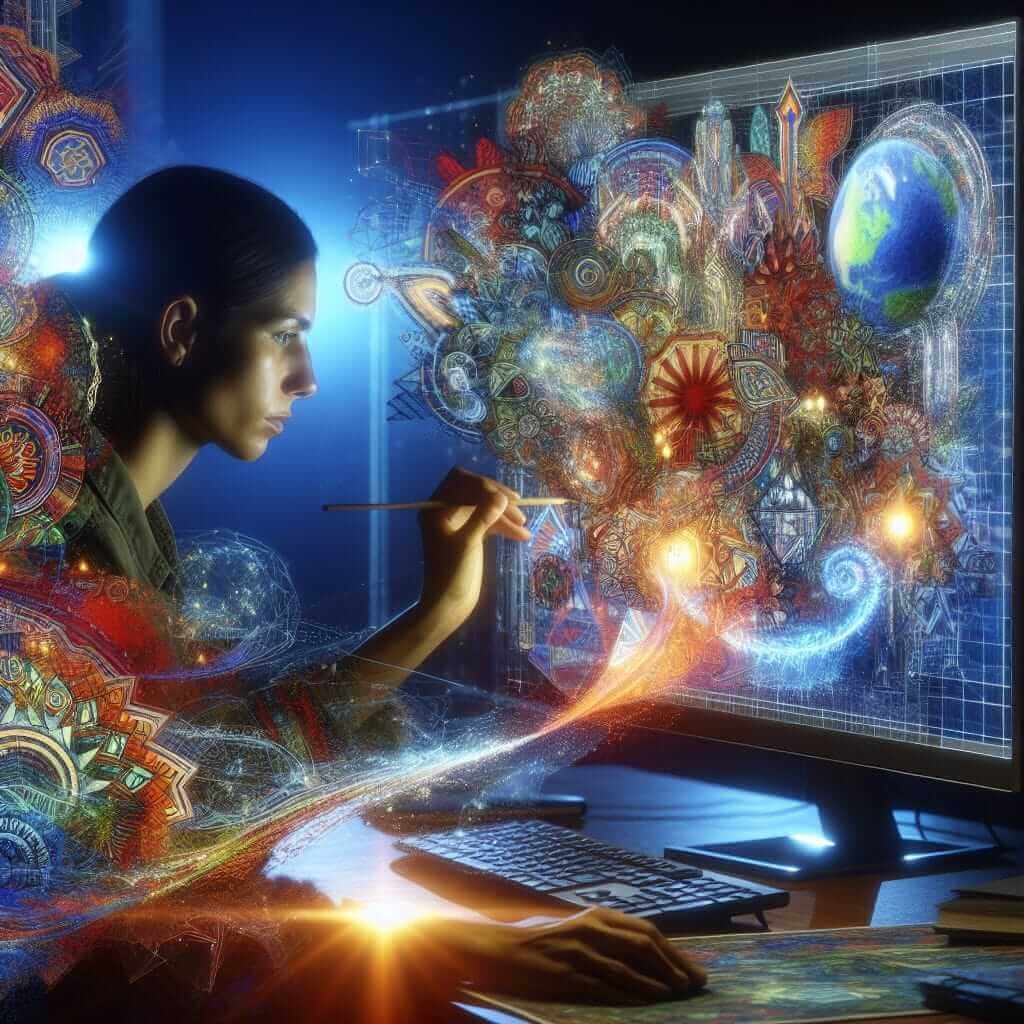The Reading section of the IELTS exam is known for its diversity in topics and complexity in passages. One frequently appearing theme is the influence of technology on culture. Today, we will delve into the “Cultural impacts of digital art,” a topic that not only reflects the changing times but also holds significant importance in modern discussions.
Throughout history, the impact of digital art on culture has seen fluctuations in frequency within IELTS exams. By analyzing past exam trends, it is evident that digitalization and its cultural impacts have gained prominence, making it a relevant topic both today and in the foreseeable future.
Let’s dive into a comprehensive IELTS Reading practice test focusing on the cultural impacts of digital art. This exercise will help you familiarize yourself with the format and types of questions you might encounter.
Reading Practice Test: Cultural Impacts of Digital Art
Passage: Cultural Impacts of Digital Art
Digital Art and Cultural Evolution
Digital art, an innovative amalgamation of technology and creativity, has significantly influenced contemporary culture. Unlike traditional forms, digital art transcends physical boundaries, promoting global accessibility and cultural exchange.
Since its emergence in the late 20th century, digital art has revolutionized the way art is perceived, created, and consumed. Artists now utilise digital tools to craft immersive experiences, allowing audiences to interact with art in unprecedented ways. Virtual reality (VR) and augmented reality (AR) exemplify these advancements, offering new dimensions to the artistic narrative.
One profound cultural impact of digital art is its role in democratizing art. The internet has bridged the gap between artists and audiences, enabling creators from diverse backgrounds to showcase their work on global platforms without institutional barriers. This accessibility has fostered an inclusive artistic environment where cultural voices that were traditionally marginalized can now thrive.
Moreover, digital art challenges the conventional notions of authorship and originality. The ease of reproduction and distribution raises questions about the value, ownership, and authenticity of art. While some argue that this dilutes the integrity of original works, others believe it fosters a collaborative and evolving artistic community.
Cultural preservation is another area impacted by digital art. Digital archives and virtual museums preserve and disseminate cultural heritage, ensuring that historical artifacts and art do not succumb to the perils of time. Digital restoration techniques rejuvenate deteriorated artworks, thus prolonging their cultural relevance.
However, the digital realm is not without its drawbacks. The ephemeral nature of digital art means it is susceptible to obsolescence, influenced by rapidly changing technologies. Artists and curators must continuously adapt to new tools and platforms to keep their work relevant.
In conclusion, the cultural impacts of digital art are multifaceted, melding innovation with tradition, and reflecting the ongoing evolution of human creativity. As digital technologies advance, so too will their ways of shaping artistic and cultural landscapes.
Questions
1. Multiple Choice
-
Digital art is known for its ability to:
- A. Limit the audience to local communities.
- B. Promote global accessibility and cultural exchange.
- C. Maintain traditional boundaries of art.
- D. Hinder artistic expression.
-
One benefit of digital art mentioned in the passage is:
- A. Restricting cultural voices.
- B. Increasing institutional barriers.
- C. Democratizing art.
- D. Decreasing reproduction of artworks.
2. True/False/Not Given
- Digital art emerged in the 21st century. ( )
- Virtual reality and augmented reality are examples of advancements in digital art. ( )
- Digital art always maintains the authenticity of original works. ( )
3. Matching Information
Match the following cultural impacts with their descriptions:
- Promoting inclusivity
- Challenging traditional authorship
- Cultural preservation
- Technological obsolescence
- A. Digital archives preserving cultural heritage
- B. Artists from diverse backgrounds showcasing work on global platforms
- C. Rapidly changing technologies affecting digital art’s relevance
- D. Raising questions of value and ownership
Answer Key and Explanations
Multiple Choice Answers:
- B. Promote global accessibility and cultural exchange.
- C. Democratizing art.
True/False/Not Given Answers:
- False. (Digital art emerged in the late 20th century)
- True.
- Not Given. (The passage mentions raised questions about value and authenticity)
Matching Information Answers:
1 – B. Digital archives preserving cultural heritage.
2 – D. Raising questions of value and ownership.
3 – A. Artists from diverse backgrounds showcasing work on global platforms.
4 – C. Rapidly changing technologies affecting digital art’s relevance.
Common Mistakes and Tips
- Misinterpreting the question: Carefully read what the question is asking; some options may be partially correct but not entirely fitting the context.
- Overlooking key details: Pay attention to specific keywords such as dates and terminologies, which are crucial for determining accuracy in True/False/Not Given questions.
Vocabulary
- Amalgamation (noun) [əˌmælɡəˈmeɪʃən]: A combination of different elements.
- Transcend (verb) [trænˈsend]: To go beyond or rise above.
- Ephemeral (adjective) [ɪˈfemərəl]: Lasting for a very short time.
- Obsolescence (noun) [ˌɒbsəˈlesəns]: The state of becoming obsolete or outdated.
Grammar Point
- Relative Clauses: Used to provide additional information about a noun without starting a new sentence.
- Example: “Artists, who now use digital tools, can interact with audiences in new ways.”
- Relative clause: “who now use digital tools”
Conclusion
To excel in the IELTS Reading section, it is crucial to practice with diverse topics like the cultural impacts of digital art. By integrating technology with traditional art forms, digital art continues to shape and influence global culture.
For further reading, explore related topics such as cultural impacts of language preservation and cultural impacts of digital communication on traditional practices.

Study Tips
- Read Widely: Diversify your reading materials to include various topics and genres.
- Practice Regularly: Simulate exam conditions to improve time management and familiarity with the test format.
- Review and Reflect: After practicing, review your answers, understand mistakes, and work on improving those areas.
By consistently following these tips and using the provided practice materials, you will increase your chances of achieving a high score in the IELTS Reading section.